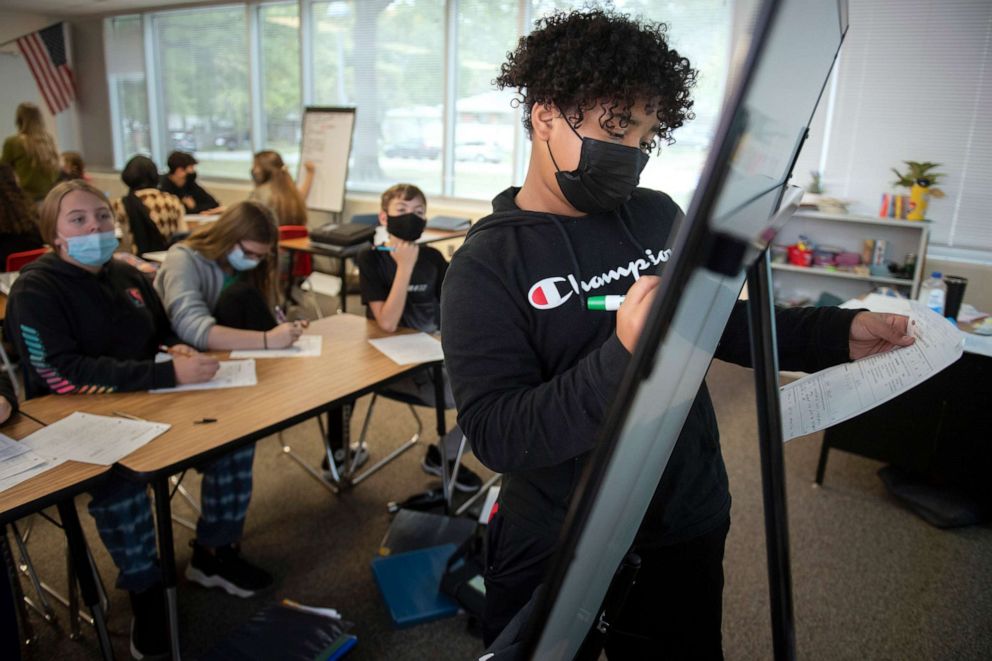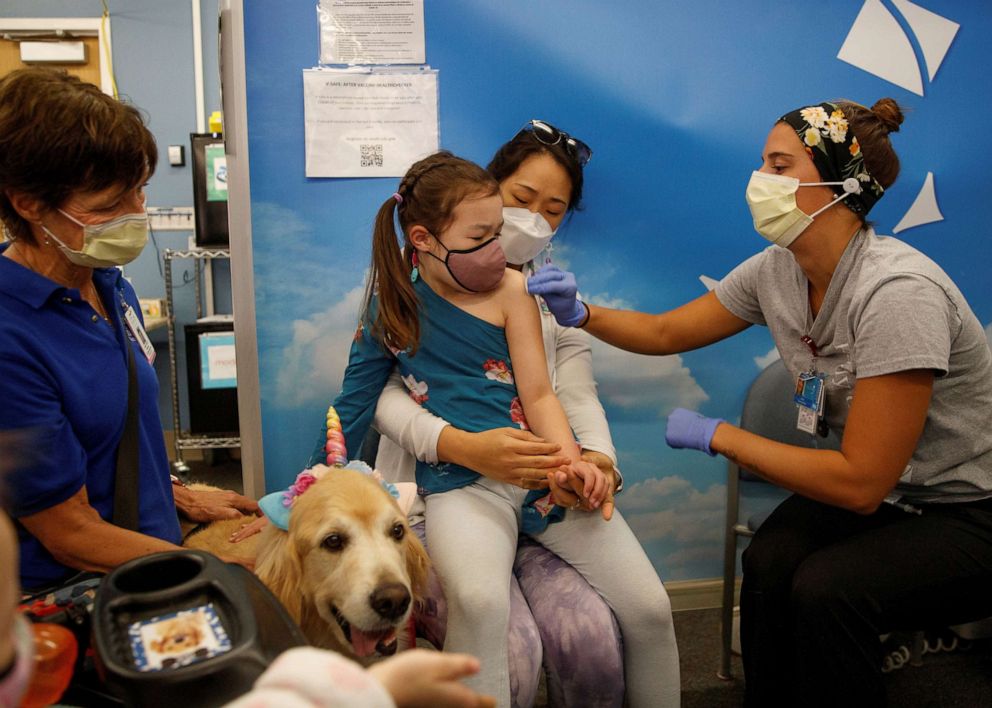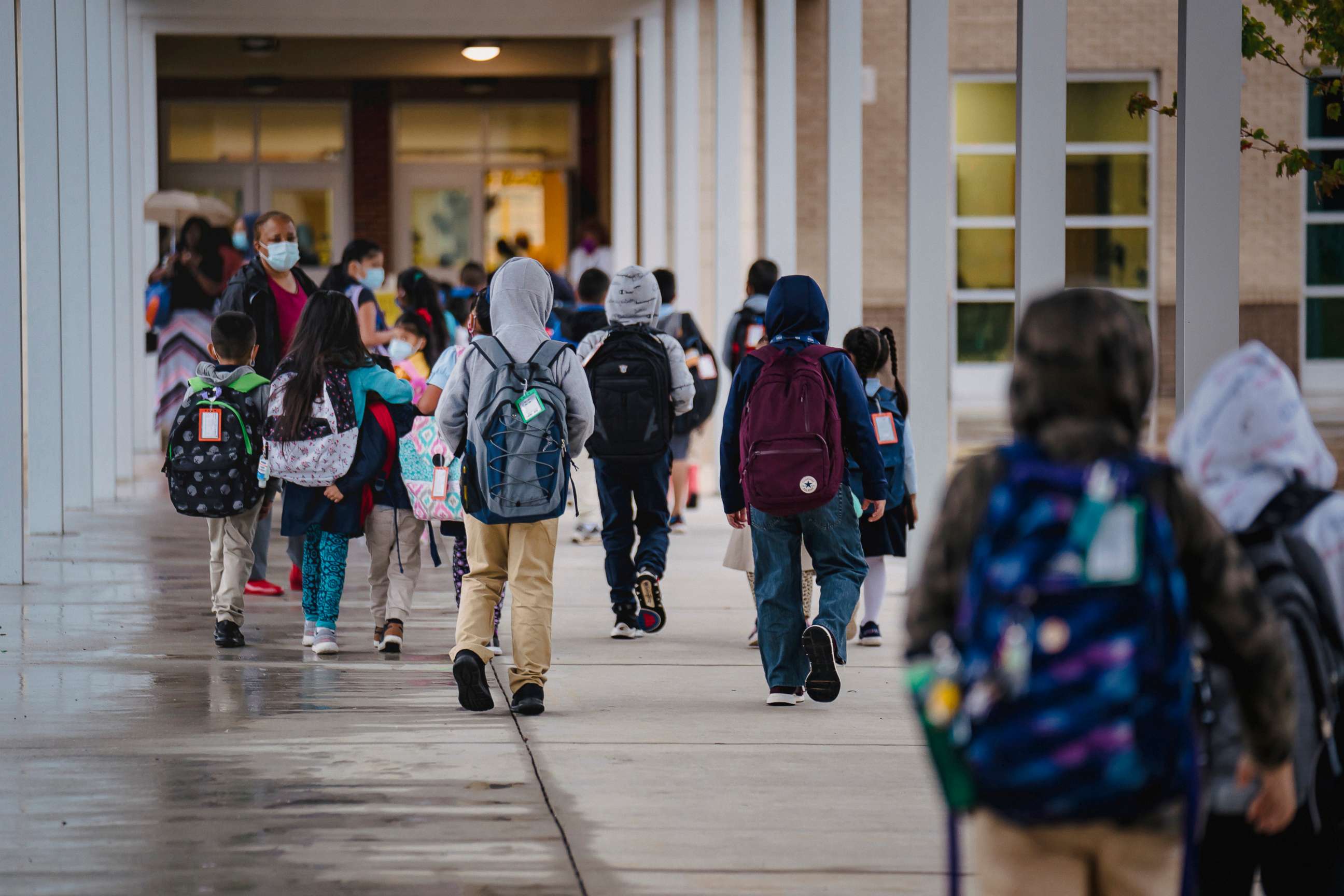Schools are dropping mask mandates, but some say not so fast
Changing protocols have ignited debate on whether it's too soon to drop masks.
As COVID-19 vaccinations continue to tick up and case and hospitalization rates decline, mask mandates for some school districts are changing, too, providing a bright spot for those hoping for a return to normalcy but caution from those who think it's too soon to drop the key intervention.
Masking in schools -- a policy that researchers say is a simple and cost-effective, non-medical COVID-19 intervention -- has been a highly politicized issue throughout the pandemic, igniting fury from parents and educators on all sides of the issue and reflecting the contentiousness of face coverings in society at large.
The patchwork of mask policies varies by state and school district, much like policies across the country at large, with several states trying to ban mandates, while others are in line with guidance from the U.S. Centers for Disease Control and Prevention recommending universal indoor masking in K-12 schools, regardless of vaccination status.
Lifting mandates currently in place may be tied to factors such as vaccination rates in school populations, community transmission and hospitalizations. And more schools are likely to revisit their masking guidelines in the coming weeks, too, as children ages 5 to 11 are now eligible for Pfizer's COVID-19 vaccine. The changing protocols, which go against current CDC guidance, have ignited debate in school districts about whether it's too soon to make masking optional, especially with colder months and holidays approaching, or not soon enough.
The largest school district in Florida, Miami-Dade, recently announced that facial coverings are now optional in its high and middle schools, following on the heels of several other counties in the state loosening their masking guidelines.
Several school districts in Georgia, including Fulton County, which includes Atlanta, have also lifted mask mandates, while ones in Michigan have set a date to end them.
According to Burbio, a company that monitors COVID-19 policies in schools, more than a dozen of the 200 largest school districts in the U.S. have dropped mask mandates in recent weeks.
As of Oct. 29, 135 of the top largest 200 districts had mask mandates, down from 150 as of Oct. 1 and the lowest total since mid-August. Among the 500 largest school districts, mask mandates have dropped from 367 to 347 in the last week as of Oct. 29, Burbio found.

Tough to roll back
Rolling back COVID-19 protocols like masking is tough to assess, experts said, especially after seeing a surge from the highly transmissible delta variant.
"Public health is often designed to add interventions as things get bad -- masking, social distancing," said John Brownstein, Ph.D., a Boston Children's Hospital epidemiologist and ABC News contributor. "It becomes a little bit more challenging around off-ramping some of these interventions, like what is the best moment to start to do away with things like masks, knowing that we have a concern about resurgence."
"We have to have an eye towards getting rid of some of these interventions, but doing so in a thoughtful way so that we don't unnecessarily create a new surge and ultimately end up back where we started," he added.
Several studies have found that schools with mask mandates have had fewer COVID-19 outbreaks and closures than schools that didn't require them.
"The most important intervention that we found is masking in schools. This is well-established in studies and subsequently has been playing out in the country," Dr. John Swartzberg, an infectious disease expert and clinical professor emeritus at UC Berkeley School of Public Health, told ABC News. "Generally speaking, where schools tend to have robust masking requirements and where the students follow those reasonably well, we're not seeing significant outbreaks and we're not seeing a lot of the need to close either classes or schools. On the contrary, in communities where masking is not utilized appropriately, we're seeing COVID take a much greater burden on the school."
Masks can also help limit quarantines; schools districts, including New York City's, have adopted CDC guidance that excludes students who were between 3 to 6 feet of an infected student from being considered a close contact as long as both were properly wearing masks.
Vaccination is also key in helping protect students and limit spread and disruptions in schools, and with younger students now able to get vaccinated, that is a "major move forward for the safety of kids in school, and the safety of our society," Swartzberg said.
Asymptomatic spread is a concern when ditching masks. Though new data shows that vaccinated people are contagious for a shorter period than those unvaccinated, in the event of a relatively uncommon breakthrough delta case.
Parents of children ages 5 to 11 are nearly evenly split on getting their children vaccinated against COVID-19 right away, taking a wait and see approach or definitely not getting it, according to the latest vaccine poll from the Kaiser Family Foundation, released before the vaccine became eligible for that age group.
It could take several months to see the "salutary effects" of vaccination among children ages 5 to 11, Swartzberg said, making masks an important intervention in the meantime.

Could help get more children vaccination
Tying high vaccination rates to loosening mask mandates could be the carrot needed to get children immunized, Brownstein said.
"Parents are so desperate for kids to get back to normal," he said. "Metrics around percent vaccinated really can do the trick."
Massachusetts singularly stands out for a statewide policy that enables high schools with at least 80% of their school community fully vaccinated to opt out of a statewide mask mandate, which was recently extended through early 2022 to allow more time for elementary-aged students to get vaccinated.
Several schools have met the criterium to make masks optional; Hopkinton High School, which has a vaccination rate over 95%, became the first to do so last week, after its district's school committee narrowly voted to approve a three-week, mask-free trial. The move comes as the 14-day average daily case rate in the district's county is 14 per 100,000 residents as of Thursday, according to state data. Some students supported the step, seeing it as a reward for following COVID-19 protocols and getting vaccinated, while committee chair Nancy Cavanaugh voted against taking away a layer of mitigation "that kept us safe," the Associated Press reported.
State officials in Maryland and Connecticut, who in recent weeks extended mask mandates in schools, are among those who are eyeing vaccination rates in potentially lifting them but biding time for vaccinations to increase before changing any protocols. After 5- to 11-year-olds could start getting vaccinated, the health department in Kalamazoo County, Michigan, announced that its mask mandate for students in kindergarten through sixth grade will end on Dec. 17, though universal masking will still be recommended.
More metrics
In addition to vaccination, districts are factoring in metrics like COVID-19 case rates, hospitalizations and students in quarantine in lifting mask mandates. Fulton County is one of several school districts in Georgia to make masks optional. It cited the rate of infection dropping below 100 per 100,000 residents for two consecutive 14-day epidemiology reports. The statewide case rate was 106 per 100,000 people for the last two weeks as of Friday, according to state health department data. Nationwide, where cases appear to be plateauing though are rising in some regions, the seven-day case rate was 150 per 100,000 people as of Friday, per CDC data.
In Miami-Dade County, the largest public school district in Florida, parents of middle and high school students could start opting out of mask requirements regardless of vaccination status by signing a form, effective Nov. 1. The move came after county cases, hospital admissions and the positivity rate fell below established thresholds for the county and school, and 84% of eligible people in schools had gotten at least one shot of the vaccine.
“We have been and continue to be and will always be a system informed not by opinion but by the expertise of public health officials and medical experts," Miami-Dade County Public Schools Superintendent Alberto Carvalho told reporters in announcing the move, which was "on the basis of significantly improved health conditions, not only in our community but also in our schools."
The county's COVID-19 weekly case counts had been below 100 per 100,000 people for two weeks when the new policy went into effect, the superintendent said.
The district is waiting on elementary school students to collect more data and allow time for students to get vaccinated, though may make an announcement there soon, too, he said.

Clear messaging key
As school districts' mask mandates change, "clear messaging for parents and transparency" will be key, Brownstein said, "especially if masks need to come back."
"Schools have to educate parents that the ways in which to begin to shed the mask sort of depend on parents getting on board with other interventions, like vaccines for kids and themselves, and be willing to get their kids tested if exposed, and other types of strategies that ultimately keep kids safe," Brownstein said.
Test-to-stay strategies have been deployed by some states and school districts to limit outbreaks and reduce quarantines. As vaccination rises, other interventions will continue to be important, including ventilation, though masking may not be necessary, Swartzberg said.
"That's the real optimistic scenario. There's a lot of variables here -- one is, of course, how many people are going to get their kids vaccinated," he said. "If we really do make a concerted effort to get K-12 vaccinated, that's going to put a real dent into how much this virus is interfering with not just schools, but in society in general."




